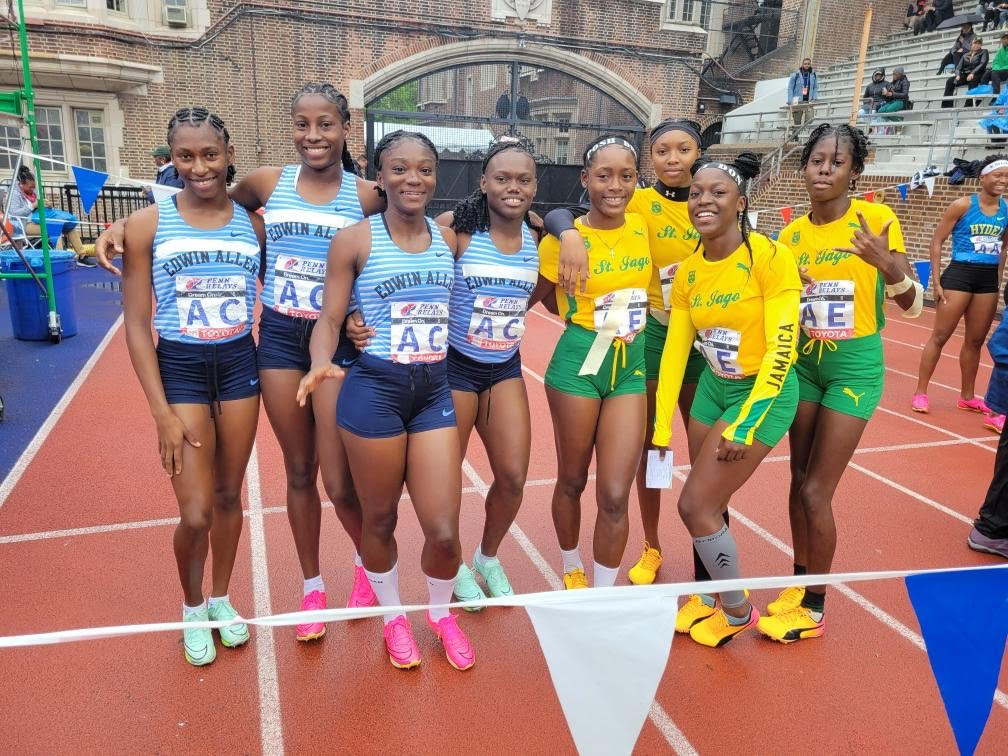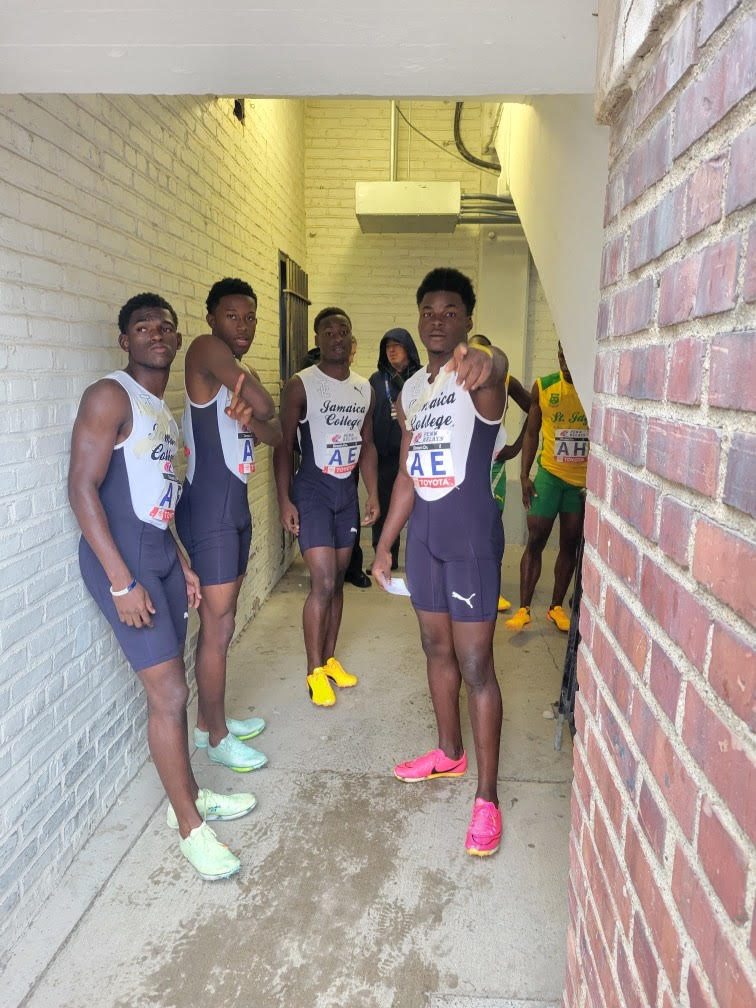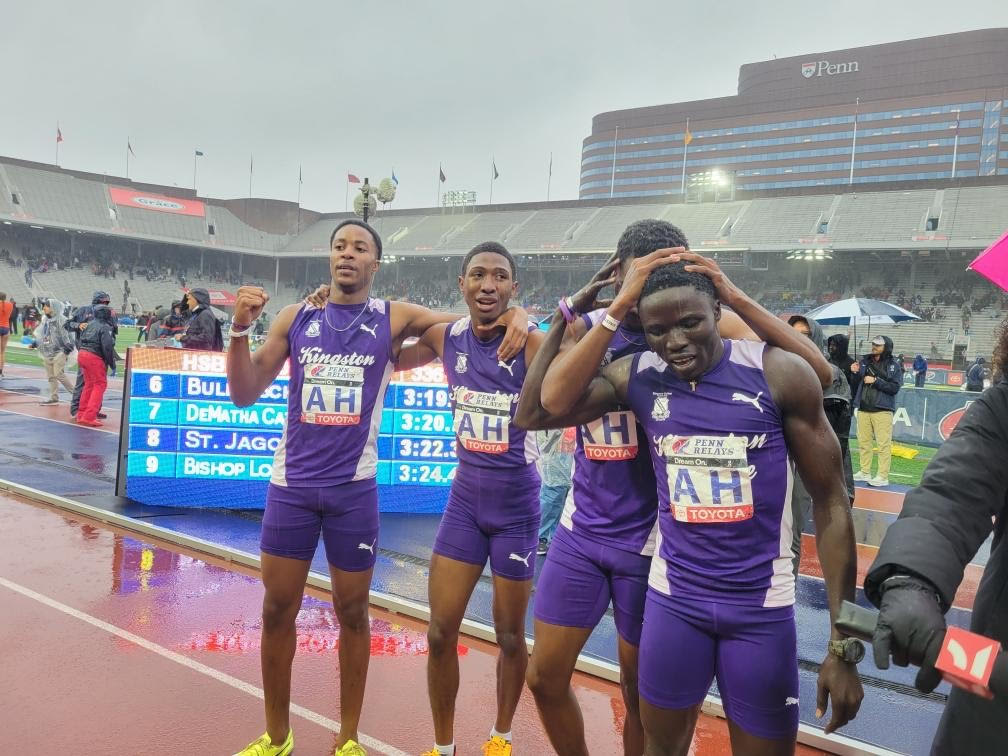The Penn Relays completed its 127th year last Saturday evening at the Franklin field facility, further entrenching itself on the USA and global athletics calendar as one of the longest running track and field meets and the world’s largest relay meet. American sports writers readily remark that Penns is also the place where track fans get to see tomorrow’s Olympic stars today, a comment shared by many in the Jamaican Diaspora as they make the annual pilgrimage to see the young Jamaican athletes who are always on show. According to reports, more than 400 student athletes and another 150 persons comprising delegations of coaches, medical personnel and chaperones made the trip this year, completing the 59th appearance of Jamaican student athletes at these Relays. As I looked at the numbers I couldn’t help but ask myself if Penn Relays is still relevant to Jamaica’s athletics development?
View: Top Photo Highlights and Moments from 2022 Penn Relays in City of Brotherly Love

Historical Background
Jamaica’s participation in Penn Relays began in 1964, an opportunity made possible by the late Herbert McKinley OJ, who had encouraged the outstanding Kingston College coach Donovan Davis to submit entries for a team at the Penn Relays after that schools’ performances at Boys Champs in 1963. Since that time, Jamaican high school participation has succeeded in transforming the annual relay carnival on the track while at the same time pulling in scores of thousands of paying Jamaicans into the Franklin Field stands. Despite the heavy financial impact from the Jamaicans on the event, it is important to know that the Penn Relays offer nothing in return to the Jamaican schools for their contribution beyond medals if they finish within the frame.
Good Read: Jamaica College Gabriel Lim Makes History at Penn Relays
Early Benefit to Jamaica
During the early years of Jamaican participation (especially during that early period 1964 through to the mid-1990s) the Penn Relays served as a connecting point for Jamaican student athletes, college recruiters and coaches scouting for talent to enrich the programs of various tertiary institutions across the United States of America. Naturally, Jamaica’s stature subsequently rose as the college circuit honed the talents of several of our athletes including the likes of Lennox Miller, Donald Quarrie, Merlene Ottey, Veronica Campbell-Brown, Raymond Stewart, just to name a few. Mind you, for every athlete that shone, many fell to the athlete graveyard as the heavy schedules took tolls on dozens of overworked athletes, while many who were unable to handle the college curriculum and the physical workload fell along the wayside.

Change in Value over Time
In the last 25 years, Jamaica has seen less of a dependence on overseas coaches as the G.C. Foster College of Physical Education’s production of a plethora of certified coaches caused positive changes in the approaches of dozens of secondary schools towards sports generally, and track & field specifically. Combined with the steady trek of retired professional athletes who have established training outfits across the island, the strength of Jamaica’s youth athletic program is a matter of record as is the island’s reputation as the top athletics nation in the Americas.
It is for this reason that instead of awaiting the arrival of Jamaican student athletes at Penn Relays, talent scouts, coaches and recruiters have established links in Jamaica to provide information on the talented athletes and to make approaches and offers to them long before even the Gibson Relays or Champs in Jamaica are run. In addition to this, Jamaica’s reputation is further buttressed by the fact that more than 85 percent of the athletes representing Jamaica on the international stage trains at home in Jamaica, making the need to go overseas to train almost completely redundant. In addition, the successes of Usain Bolt, Asafa Powell, Shelly-Ann, and others has resulted in a growing number of junior athletes electing to go straight into the professional ranks as opposed to the traditional move to a college education overseas followed by a professional athletic career.

Overseas Travel Benefit
It would be dishonest to ignore the view that sending the youngsters to Penn Relays provides not only an attractive reward to the student athlete at the end of their season, but also provides an opportunity for foreign travel and the much-valued US Visitors visa. What is hardly ever given meaningful consideration is the cost and any cost/benefits analysis. Penn Relays after all, is an expensive anachronism. It costs the average athlete/entourage member more than US$1,200.00 to make the trip and all told, Jamaica is spending just under an estimated US$1 million dollars to finance such a venture to which the return on investment is almost zero.
Keep in mind that the Penn Relays provides a major financial boon not only for the University of Pennsylvania which has in the last 10 years welcomed more than 60,000 paying patrons (nearly eighty percent being Jamaicans) annually through their turnstiles at an average US $55.00 per patron. These revenues provide a major injection for the Franklin Field community specifically, and the general Philadelphia business community, which in turn provides absolutely nothing for our athletes. What makes this even more interesting is the fact that in the more than 50 years that Jamaican teams have participated, not a single Jamaican high school student has ever received a scholarship to attend the University of Pennsylvania. In fact, beyond the use of its track facilities, the University of Pennsylvania and its organizers do not even provide lunches for the members of these teams. Meals and other refreshments have in recent years been provided by the Diaspora group “Team Jamaica Bickle.”
Time for Jamaica to Leverage its clout as a Track Powerhouse
Today, Jamaica is revered not only as one of the most powerful countries in world athletics, but also as the place where the world’s fastest men and women reside and train. Both the University of Technology and the University of the West Indies now provide successful track programs and offer scholarships to our best athletes. It is my view that the time has come for Jamaica to use its gigantic clout in the sport and create an international invitational Age-Group Meet for colleges and high schools as an option to the Penn Relays.
I strongly believe that it is high time that we Jamaicans recognize our advantages and capitalize on them. Jamaica has the talent and the programs that currently produce the best athletes at high school and college levels and the Americans who are beneficiaries of the competition provided by the Jamaicans will come. This is Sports Tourism 101, and it is up to our design and marketing teams to create a product to satisfy that market, the benefits are simply too significant to ignore. The earning potential for the island is huge as the meet will become a net generator of foreign exchange and transfer those revenues to local businesses as opposed to the close to one million in US currency spent by athletes and teams around the Penn Relays.
About the Author
 Richard Hugh Blackford is the host of a 2-hour music-driven internet show Sunday Scoops on yaawdmedia.com each Sunday from 2:00 pm – 4:00 pm. The show focuses on Foundation Jamaican Music and takes its audience on a nostalgic but historical musical journey, peeling back the years of Jamaican musical development as the hosts explore the careers of Jamaican artistes. Sunday Scoops provides interviews with personalities, and discussions on Jamaican music and other topical issues. The show is co-hosted by noted DJ Garth Hendricks.
Richard Hugh Blackford is the host of a 2-hour music-driven internet show Sunday Scoops on yaawdmedia.com each Sunday from 2:00 pm – 4:00 pm. The show focuses on Foundation Jamaican Music and takes its audience on a nostalgic but historical musical journey, peeling back the years of Jamaican musical development as the hosts explore the careers of Jamaican artistes. Sunday Scoops provides interviews with personalities, and discussions on Jamaican music and other topical issues. The show is co-hosted by noted DJ Garth Hendricks.
Photo – Nick Ford
Is Penn Relays Still Relevant To Jamaica’s Athletics Development
The Penn Relays completed its 127th year last Saturday evening at the Franklin field facility, further entrenching itself on the USA and global athletics calendar as one of the longest running track and field meets and the world’s largest relay meet. American sports writers readily remark that Penns is also the place where track fans get to see tomorrow’s Olympic stars today, a comment shared by many in the Jamaican Diaspora as they make the annual pilgrimage to see the young Jamaican athletes who are always on show. According to reports, more than 400 student athletes and another 150 persons comprising delegations of coaches, medical personnel and chaperones made the trip this year, completing the 59th appearance of Jamaican student athletes at these Relays. As I looked at the numbers I couldn’t help but ask myself if Penn Relays is still relevant to Jamaica’s athletics development?
View: Top Photo Highlights and Moments from 2022 Penn Relays in City of Brotherly Love
Historical Background
Jamaica’s participation in Penn Relays began in 1964, an opportunity made possible by the late Herbert McKinley OJ, who had encouraged the outstanding Kingston College coach Donovan Davis to submit entries for a team at the Penn Relays after that schools’ performances at Boys Champs in 1963. Since that time, Jamaican high school participation has succeeded in transforming the annual relay carnival on the track while at the same time pulling in scores of thousands of paying Jamaicans into the Franklin Field stands. Despite the heavy financial impact from the Jamaicans on the event, it is important to know that the Penn Relays offer nothing in return to the Jamaican schools for their contribution beyond medals if they finish within the frame.
Good Read: Jamaica College Gabriel Lim Makes History at Penn Relays
Early Benefit to Jamaica
During the early years of Jamaican participation (especially during that early period 1964 through to the mid-1990s) the Penn Relays served as a connecting point for Jamaican student athletes, college recruiters and coaches scouting for talent to enrich the programs of various tertiary institutions across the United States of America. Naturally, Jamaica’s stature subsequently rose as the college circuit honed the talents of several of our athletes including the likes of Lennox Miller, Donald Quarrie, Merlene Ottey, Veronica Campbell-Brown, Raymond Stewart, just to name a few. Mind you, for every athlete that shone, many fell to the athlete graveyard as the heavy schedules took tolls on dozens of overworked athletes, while many who were unable to handle the college curriculum and the physical workload fell along the wayside.
Change in Value over Time
In the last 25 years, Jamaica has seen less of a dependence on overseas coaches as the G.C. Foster College of Physical Education’s production of a plethora of certified coaches caused positive changes in the approaches of dozens of secondary schools towards sports generally, and track & field specifically. Combined with the steady trek of retired professional athletes who have established training outfits across the island, the strength of Jamaica’s youth athletic program is a matter of record as is the island’s reputation as the top athletics nation in the Americas.
It is for this reason that instead of awaiting the arrival of Jamaican student athletes at Penn Relays, talent scouts, coaches and recruiters have established links in Jamaica to provide information on the talented athletes and to make approaches and offers to them long before even the Gibson Relays or Champs in Jamaica are run. In addition to this, Jamaica’s reputation is further buttressed by the fact that more than 85 percent of the athletes representing Jamaica on the international stage trains at home in Jamaica, making the need to go overseas to train almost completely redundant. In addition, the successes of Usain Bolt, Asafa Powell, Shelly-Ann, and others has resulted in a growing number of junior athletes electing to go straight into the professional ranks as opposed to the traditional move to a college education overseas followed by a professional athletic career.
Overseas Travel Benefit
It would be dishonest to ignore the view that sending the youngsters to Penn Relays provides not only an attractive reward to the student athlete at the end of their season, but also provides an opportunity for foreign travel and the much-valued US Visitors visa. What is hardly ever given meaningful consideration is the cost and any cost/benefits analysis. Penn Relays after all, is an expensive anachronism. It costs the average athlete/entourage member more than US$1,200.00 to make the trip and all told, Jamaica is spending just under an estimated US$1 million dollars to finance such a venture to which the return on investment is almost zero.
Keep in mind that the Penn Relays provides a major financial boon not only for the University of Pennsylvania which has in the last 10 years welcomed more than 60,000 paying patrons (nearly eighty percent being Jamaicans) annually through their turnstiles at an average US $55.00 per patron. These revenues provide a major injection for the Franklin Field community specifically, and the general Philadelphia business community, which in turn provides absolutely nothing for our athletes. What makes this even more interesting is the fact that in the more than 50 years that Jamaican teams have participated, not a single Jamaican high school student has ever received a scholarship to attend the University of Pennsylvania. In fact, beyond the use of its track facilities, the University of Pennsylvania and its organizers do not even provide lunches for the members of these teams. Meals and other refreshments have in recent years been provided by the Diaspora group “Team Jamaica Bickle.”
Time for Jamaica to Leverage its clout as a Track Powerhouse
Today, Jamaica is revered not only as one of the most powerful countries in world athletics, but also as the place where the world’s fastest men and women reside and train. Both the University of Technology and the University of the West Indies now provide successful track programs and offer scholarships to our best athletes. It is my view that the time has come for Jamaica to use its gigantic clout in the sport and create an international invitational Age-Group Meet for colleges and high schools as an option to the Penn Relays.
I strongly believe that it is high time that we Jamaicans recognize our advantages and capitalize on them. Jamaica has the talent and the programs that currently produce the best athletes at high school and college levels and the Americans who are beneficiaries of the competition provided by the Jamaicans will come. This is Sports Tourism 101, and it is up to our design and marketing teams to create a product to satisfy that market, the benefits are simply too significant to ignore. The earning potential for the island is huge as the meet will become a net generator of foreign exchange and transfer those revenues to local businesses as opposed to the close to one million in US currency spent by athletes and teams around the Penn Relays.
About the Author
Photo – Nick Ford
More Stories
Interview: Jamaican Author Lynda Edwards Talks ‘I Am Cuba,’ Caribbean History, and Finding Her Voice
This Jamaican American Basketball Star Could Be the #1 Pick in the 2026 NBA Draft
Anancy Festival 2025 Celebrates Caribbean Heritage with Stories, Music, and Culture
This Jamaican Canadian Ice Hockey Player Was The First Black Player Picked In The 2025 NHL Draft
On This Day: July 4, 1959, The Cayman Islands Cease Being a Jamaican Dependency